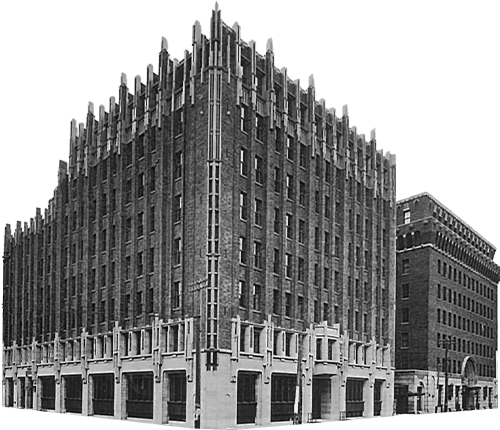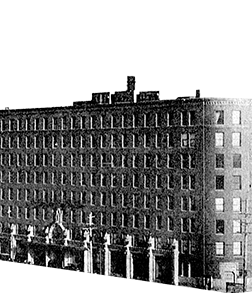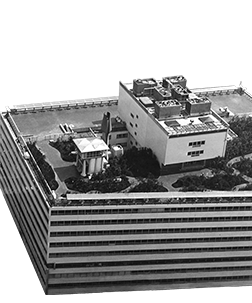 02
1927 1931
02
1927 1931
Tokyo
Hibiya Daibiru Buildings
No. 1 and No. 2
Early Expansion to Tokyo Through Aggressive Management Policies
"Cool in Summer, Warm in Winter, Service First"
Hibiya Daibiru Building No. 2 received the latest equipment just like Building No. 1, but what was noteworthy was the installation of its ventilation and cooling system. With the exception of the top floors (the seventh and eighth floors), all floors from the basement up to the sixth floor were ventilated throughout the year and completely air conditioned in summer, creating an office environment that was revolutionary for its time. The groundbreaking nature of this development can be seen in the fact that newspaper advertisements of that time promoted it by saying “the Osaka Building is cold in summer (building-wide air conditioning).”
No advertisement would bother mentioning that today. It should be noted that elevator girls, who normally were hired only by department stores, were also used in this rental office building. At the time, rental office buildings usually hired male elevator attendants, so this was the first time women were hired for that job. Whether it was due to the air conditioning in all offices or the use of elevator girls, Hibiya Daibiru Building No. 2 offered a level of luxury that defied conventional wisdom, which is why we started using the slogan “cool in summer, warm in winter, service first.”
Like Building No. 1, Building No. 2 got off to a difficult start with a lackluster occupancy rate upon opening, but the occupancy rate gradually increased. Its tenants included the Soviet Trade Office, the film production company Metro-Goldwyn-Mayer Studios Inc. (MGM), and Western Electric, an American company (that went defunct in 1995) that was selling audio equipment for “talkies” or films with sound, which had hardly been developed in Japan at the time.
-
1927 1931 Hibiya Daibiru Buildings
No. 1 and No. 2 -
2007 International Operations
-
- An Unexpected Discovery of a Good Property
- Mutual Trust and a Long-Term Perspective as Points of Agreement
- The Acquisition of a Property in Hanoi Through Unity of Philosophy
- Implementing Daibiru Quality Through Building Renovations
- Challenges in Australia, Our Second Overseas Expansion Target
- The Discovery of 275 George Street
- Difficult Contract Negotiations with JHG
- Overcoming Several Unexpected Difficulties
-



